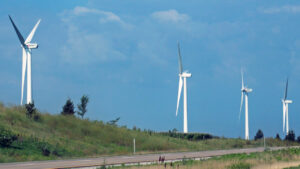Revisions to Linn County’s utility-scale wind energy ordinance are on their way to the county Board of Supervisors, after the Planning & Zoning Commission narrowly recommended approval of the revised ordinance at their meeting May 20.
Linn County senior planner Mike Tertinger said the county began considering revisions to its existing utility-scale wind ordinance about two years ago, in the wake of the county’s extensive, and occasionally contentious, review and eventual approval of industrial-scale solar projects near Coggon and near the former Duane Arnold nuclear energy plant in Palo.
The revised ordinance (see full text below) closely mirrors many of the provisions in the county’s current solar ordinance, including sections addressing the rights of participating and non-participating landowners near a project site, minimum setbacks, agricultural and environmental impacts, emergency response plans and decommissioning plans.
However, the proposed ordinance does include sections specifically addressing wind turbines, including maximum turbine heights, aircraft safety, impact on birds and their migratory paths, and analysis of “shadow flicker” caused by rotating turbine blades.
It’s essentially a “complete revision and replacement” of the existing wind ordinance, Mr. Tertinger said, including replacing the term “wind farms” with “utility-scale wind energy conversion systems” to more accurately describe their function.

Mr. Tertinger stressed that there are no utility-scale wind energy projects currently proposed in Linn County.
“The amendment at this time is basically to make Linn County better prepared, strengthen and add specificity to the existing ordinance prior to a future project coming in,” he said. “What staff has tried to do during this review period is strike a balance. We learned definitely during the solar ordinance mandates that trying to find a balance between renewable energy projects and community priorities is of utmost importance here.”
He also noted that the Linn County ordinance, drafted after extensive research and examination of current utility-scale wind ordinances in more than 30 counties, is taking a “more conservative” approach to the balance between developers and Linn County residents.
“We’re taking more of the adjoining property owners into account on several of these (ordinance sections), as far as leaning towards their protections,” Mr. Tertinger said.
County officials received a number of written comments from the public on the proposed revisions. Many felt the draft ordinance was inconsistent with the county’s existing comprehensive plan and added new regulatory barriers to the development of wind energy projects, raising costs for potential developers.
About a half dozen speakers addressed the proposed revisions at the Planning & Development Commission meeting. Many expressed concerns that the new ordinance would impose “poison pill” restrictions that could prevent developers from proposing wind energy projects.
Speakers expressed dissenting views on the ordinance’s proposed 45-decibel noise limit for wind turbines – some indicating the level was too low to be practical, others saying they felt it was appropriate to protect adjoining landowners’ interests.
Randy Walker of Cedar Rapids said the noise generated by wind turbines could adversely impact nearby chicken, cattle or hog confinements. “This could be a very real impact to our rural county,” he said. “45 decibels is not unfair, and I think it should be measured before and after, not with a guy mowing his lawn.”
Conversely, Phil Engen of Cedar Rapids, Iowa state coordinator for the nationwide Citizens’ Climate Lobby, said he felt the 45-decibel noise limit was excessively restrictive, noting that he had been measuring the sound level at the commission meeting and it never dropped below 45 decibels.
“By comparison, a city street average is about 70 decibels,” he said. “I think 70 decibels is a much more realistic value for the noise ordinance.”
Board members Tina DuBois and Griffin Kuntz said they favored raising the noise limit from 45 to 55 decibels, but the level remained unchanged in the commission’s final vote.
The commission eventually voted 3-2 to recommend the revised ordinance for approval by the board of supervisors, with just one recommended change – one requiring wind turbine owners to be responsible for debris removal if a wind turbine is damaged, wherever that debris may land.
The first consideration of the revised wind ordinance by the full Linn County Board of Supervisors is set for June 3.